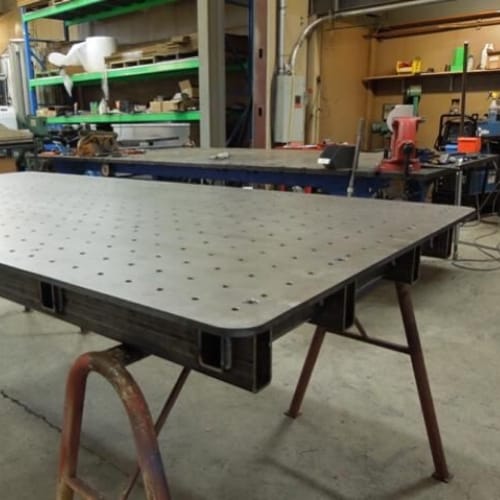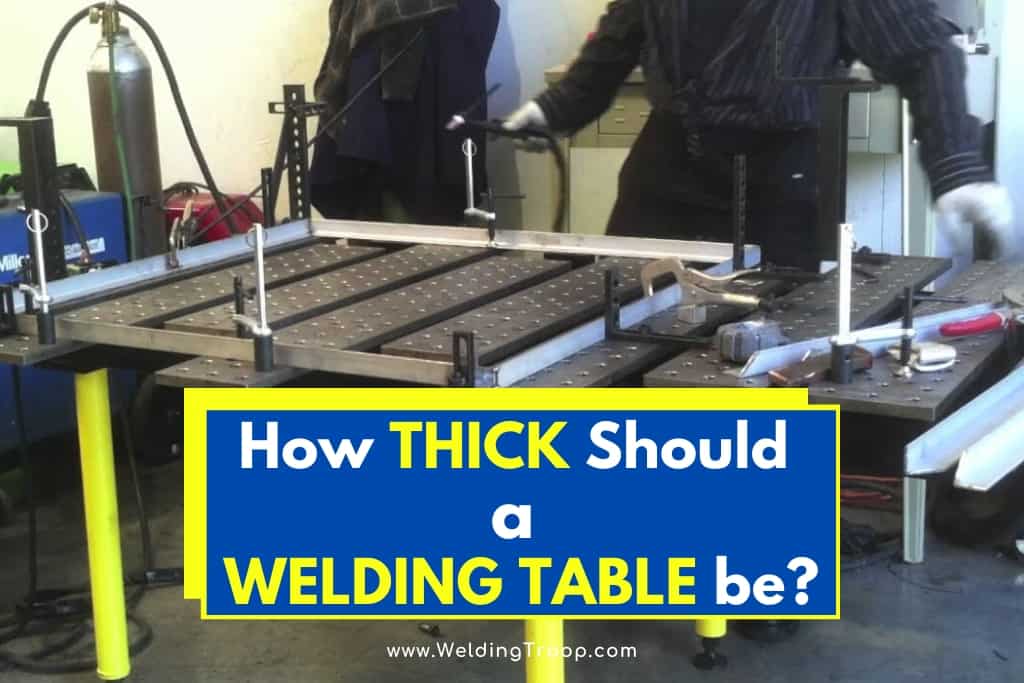If you have ever had the opportunity to weld or witnessed anyone in the business of welding, you have likely noticed the table they use to complete the job. When you are working with high voltage and high-temperature tools, you cannot rely on a lightweight material to offer support.
How thick should a welding table be? The thickness of a welding table can be between ¼ of an inch up to 3 inches in thickness. However, there is not a set thickness that a welding table should be. However, you want to make sure you have something strong enough to support the weight of the materials you will be welding.
In this article, you will learn about how thick an adequate welding table should be for the job you are hoping to accomplish.
Table of Contents
Welding Table Thickness
When you begin putting your shop together, you will want to invest in a welding table. You can purchase a pre-made table, or you can make your own using scrap metal. No matter which route you choose to go, you need to make sure the metal is thick enough to support the work you intend to do on it.
Most welders will recommend a welding table that is between ¼ and 3 inches thick. However, the work you plan to do will dictate the thickness of the table you need to have.
- ¼ inch metal: This thickness of metal is ideal if you are welding lightweight materials, typically used by a hobbyist. Because this table will be relatively lightweight, you may run the risk of warping or bending when heavier materials or larger welding tools are used on or around it.
- 1-2-inch metal: When you begin looking at this thickness of metal, you are likely using a heavy-duty welding machine and much more substantial materials. The thickness of this table will ensure that it can not only hold the material being welded, but it can also handle the heat of the welding machine without damage.
- 3-inch metal: This is going to be an extremely heavy-duty welding table and is not completely necessary unless you are welding heavy machines. This will not only be incredibly durable, but it will allow you to place clamps around the perimeter as needed.
Considerations
If you are planning to do any form of heavy-duty welding, you are going to need a stable and thick welding table. Putting heavy machinery on top of a thin table will likely end in a damaged table, equipment, and potential injury to the welder.
When choosing the thickness of your table, you need to consider the following factors:
- Use of the table: What will you be using the table for? Are you planning on industrial type welding jobs, or are you using it more for hobby welding? When you answer this question, you will be able to determine the thickness of the table that will work well for your purpose.
- Location: Where will the table be located? The thicker the tabletop, the heavier it is to move. If you are planning to build or purchase a solid welding table, you need to know how difficult it will be to move. Therefore, it is essential to place heavy welding tables in the place they will remain in.
- Cost: Like any project or major purchase, you need to consider the cost. If you are in a position where money is not an issue, then you are lucky. The sky is the limit when it comes to your table. However, if you are money-conscious like most people, you want to spend wisely. The cost of welding tables can vary greatly depending on the thickness of the table. You can purchase a portable welding table that is relatively thin for around $150, while a heavy-duty welding table can cost upwards of $9,000.
- Attachments: When you are welding, you will likely want to attach items to the side of the welding table. To do this, you will need a table thick enough to support the clamps you need to use adequately. This can be problematic if you are using a very thin table. However, there are ways that you can get around this if need be.
- Portability: Zander Buel of The Tulsa Welding School expresses the interest welders may have in moving their table for ease of use in his article How to Choose a Welding Table. If this is the case, a lighter material will be the best choice. However, it is crucial to keep in mind that a portable table will need to be used for lighter jobs.

What Material Should You Use to Make a Welding Table?
You may now be wondering what materials should be used when making a welding table. The most durable metal you can use is a solid steel plate; however, this is going to be extremely heavy and needs to be in a permanent location. According to Welding Tips and Tricks, there are several factors to include in your decision when determining the material you need to use:
- Aluminum: If you are working with light-duty welding jobs, you can get away with using a thin aluminum sheet over a wood-topped table. The downfall may be the inability to clamp anything to the table because of the thickness of the table.
- Stainless Steel: If you are welding light duty objects, you can also use a food-grade stainless steel table. While this would not be a feasible option for heavy-duty welding, it could be useful for small projects.
- Cast Iron: If you are looking for something that is super heavy-duty, you can use cast iron. If you have ever held a cast iron pot or pan, you know how dense this material is. The weight of the table will be significant and will likely hold up well under extreme heat and weight.
Should You Make a Table or Buy One?
You may be wondering if it is more economical to make a welding table or buy a pre-made table. If you are planning to purchase a welding table, you will need to spend a significant amount of money, but you will also save lots of time.
How Long Does It Take to Build a Table?
If you plan to build a welding table, you need to make sure that you set enough time aside to complete the job. To build a sturdy welding table, you will likely need to set aside several hours to do so; therefore, this cannot be a spur of the moment decision.
Where Can You Get Materials?
You can buy metal from many home centers and hardware stores. However, it will likely be a lightweight metal. If you want a thick metal, you will need to go to a metal supplier where you can purchase metal to meet your specifics.
Do You Need to Be an Experienced Welder to Build a Table?
While you do not need to be an experienced welder to build a functional table, you will want to make sure you measure correctly to fit the specifications you have in mind. You need to ensure the table has enough support to hold both the top and any object you may place on top of the table to weld.
Because this is a safety issue, you may want to enlist the help of an experienced welder to help with the project, both with measuring and building the table.
Final Thoughts
When looking at welding tables, whether to build or purchase, you need to be confident you have the correct thickness to ensure the usability for the purpose you have in mind. You also want to make sure it is safe to hold the materials you want to weld, without causing damage or injury.
Recommended Reading
Can You Paint a Welding Table?
Should Welding Tables Be Grounded?
Why do Welding Tables Have Holes? >> Tips and Tricks You Need To Know
What To Consider When Building A Welding Table >> Check out the video below

